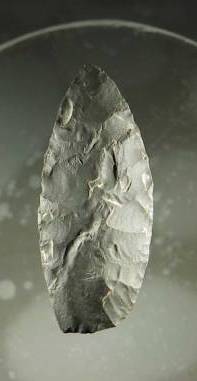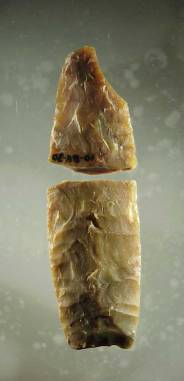

The Wasden site, overwhelmingly, consists of faunal remains, and as such those take the primary role in influencing the interpretation of the site. The Wasden site is a predominately a natural animal trap that was used by activity groups for differing purposes over the past 11, 000 years. The earlier use is that of a short term campsite in which modification of proboscidean bone occurred (Miller 1982, 1989). A later use, the bison drive, was that of butchering episodes, with out any evidence that people stayed within the cave for any length of time (Butler 1978). Found in the archaeological record for this occupation of the Wasden site is the disarticulated remains of over 70 bison, estimated (Butler 1986:129). Along with these disarticulated, and arguably arranged, remains, are 62 artifacts. These artifacts appear to be expedient tools used for the butcher of the bison. Most of the tools are formed projectile points, which appear to be the tools that were used for the butchering process. They were the only tools present and even though they are not ideal for butchering are functional for that purpose. The only tool that Butler (1968:12-13) identifies as being useful for the butcher of the bison is a flesher (specimen 76271) made from the nasal bone of a bison. Butler (1968b:13) does not propose the possibility that the projectile points could have been used for the butcher of the bison. However, the only tools present are these tools. It is the expedient use of those tools that were at hand for the butcher of the bison.
| Figure 32. Specimen 76269. |  |
 |
| Figure 14. Specimen 75478. |
 |
Figure 15. Specimen 75478 close up of polish. |  |
| Figure 16. Specimen 76305. |  |
Figure 17. Specimen 76305 close up of grinding. |  |
| Figure 18. Specimen 76276. |  |
Figure 19. 76276 close up of striation. |  |
Wasden is the reconstruction of specific behaviors and event centered history, but in so far as that may be all that can be said of the site at this time. The archaeological record for the surrounding area lacks the documentation for this time period to articulate the Wasden site with into a larger construction. In Idaho, few of the published reports of sites have the time depth of Wasden and most of these lack the material recovered at Wasden. Wilson Butte Cave, by example, in the Wilson Butte II assemblage has only a few points (N=5) that have been described as Plano, but have almost no faunal association (Gruhn 1961:118-119, Plew 2000:37). The only faunal associated with Wilson Butte Assemblage II is a fragment of a grooved bird bone (Gruhn 1961:119). Bison and Veratic Caves (Swanson 1972) also have Plano material, but once again are without faunal association. Only at the Haskett site (Butler 1965), where Haskett was recovered along with fragments of enamel from bison teeth, is there any indication of faunal remains in association with similar artifactual materials. This leaves the Wasden site as the only dated site, for the time period, in which there is a possibility of recovering human behavior. The Wasden site is thus a reconstruction of specific behaviors, until more information is introduced for the region allowing some level of synthesis.
The significance of the Wasden site cannot be overstated. The two published layers represent unique events in the archaeological record. The archaeological record often consists of secondary or tertiary refuse (artifacts discarded away from their primary use location) and as such losing much of their direct behavioral information (Schiffer 1985). The Wasden site, in contrast, presents primary behavioral information in the remains recovered from layer 17. The two published layers are unique discrete events, and are important in understanding hunter-gatherer ecology on the Snake River Plain. The spatial analysis of the Wasden site based on the patterning of meat procurement. The Wasden site offers an interesting glimpse into paleoindian hunting and gathering economy. The bison bone bed contains over 70 bison (Butler 1986:129). It would seem to have evidence that would point to bison procurement (entrapment, disposal), butchering practices, and further it should have implications to what are culturally preferred eating practices in meat preference.
Next II Back
II List of Figures